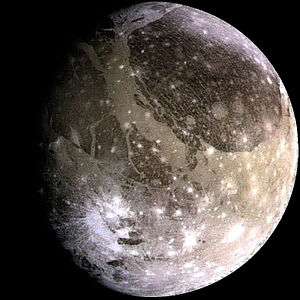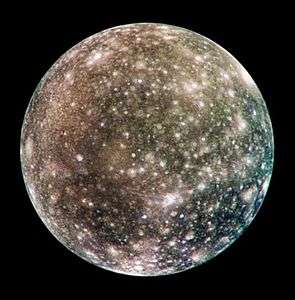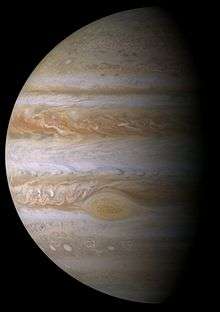Jupiter Icy Moons Explorer
|
An artist's impression of the JUICE mission | |||||||
| Mission type | Planetary science | ||||||
|---|---|---|---|---|---|---|---|
| Operator | ESA | ||||||
| Mission duration |
7.6 years cruise; 3.5 years in the Jovian system. | ||||||
| Spacecraft properties | |||||||
| Manufacturer | Airbus Defence and Space | ||||||
| Power | Solar array of about 100 m2[1] | ||||||
| Start of mission | |||||||
| Launch date | 2022 | ||||||
| Rocket | Ariane 5 ECA | ||||||
| Launch site | Guiana Space Centre ELA-3 | ||||||
| Jupiter orbiter | |||||||
| Orbital insertion | 2030 | ||||||
| Ganymede orbiter | |||||||
| Orbital insertion | 2033 | ||||||
| Flyby of Europa | |||||||
| Flyby of Callisto | |||||||
| |||||||
The JUpiter ICy moons Explorer (JUICE) is a planned European Space Agency (ESA) spacecraft designed by Airbus Defence and Space to visit the Jovian system, focused on studying three of Jupiter's Galilean moons: Ganymede, Callisto, and Europa (excluding the more volcanically active Io).[2] It will characterise these three worlds, all of which are thought to have significant bodies of liquid water beneath their surfaces, making them potentially habitable environments. The selection of this mission for the L1 launch slot of ESA's Cosmic Vision science programme was announced on 2 May 2012.[3]
History
The mission started as a reformulation of the Jupiter Ganymede Orbiter proposal, which was to be ESA's component of the cancelled Europa Jupiter System Mission—Laplace (EJSM-Laplace).[4] It became a candidate for the first L-class mission (L1) of the ESA Cosmic Vision Programme, and its selection was announced on 2 May 2012.[3] In April 2012 JUICE was recommended over the proposed ATHENA X-ray telescope and a gravitational wave observatory (New Gravitational wave Observatory (NGO)).[5][6] In July 2015, Airbus Defence and Space was selected as the Prime Contractor to design and build the probe. [7]
Plan
A proposed timeline is launch in 2022 on an Ariane 5 carrier rocket and arrival at the Jupiter system in 2030.[2] By 2033 the spacecraft should enter orbit around Ganymede, after completing various manoeuvres around Jupiter and the other moons.[2] Proposed instruments include cameras, spectrometers, and an ice-penetrating radar.[2][8][9]
Science objectives

The JUpiter ICy moons Explorer (JUICE) will perform detailed investigations on Ganymede as a planetary body and evaluate its potential to support life. Investigations of Europa and Callisto will complete a comparative picture of these Galilean moons.[10] The three moons are thought to harbour internal liquid-water oceans, and so are central to understanding the habitability of icy worlds.
The main science objectives for Ganymede, and to a lesser extent for Callisto, are:[10]
- Characterisation of the ocean layers and detection of putative subsurface water reservoirs;
- Topographical, geological and compositional mapping of the surface;
- Study of the physical properties of the icy crusts;
- Characterisation of the internal mass distribution, dynamics and evolution of the interiors;
- Investigation of Ganymede's tenuous atmosphere;
- Study of Ganymede's intrinsic magnetic field and its interactions with the Jovian magnetosphere.
For Europa, the focus is on the chemistry essential to life, including organic molecules, and on understanding the formation of surface features and the composition of the non-water-ice material. Furthermore, JUICE will provide the first subsurface sounding of the moon, including the first determination of the minimal thickness of the icy crust over the most recently active regions.
Spacecraft
Mission conditions and design
The main spacecraft design drivers are related to the large distance to the Sun, the use of solar power, and Jupiter's harsh radiation environment. The orbit insertions at Jupiter and Ganymede and the large number of flyby manoeuvres (more than 25 gravity assists, and two Europa flybys) requires the spacecraft to carry about 3,000 kg (6,600 lb) of chemical propellant.[11]
Gravity assists include:[12]
- Interplanetary transfer (Earth, Venus, Earth, Earth)
- Jupiter orbit insertion and apocentre reduction with multiple Ganymede gravity assists
- Reduction of velocity with Ganymede–Callisto assists
- Increase inclination with 10–12 Callisto gravity assists
Ganymede Lander
The Russian Space Research Institute is currently evaluating a Ganymede lander mission called Laplace-P, with emphasis in astrobiology. Cooperation and a possible synergy with JUICE Ganymede orbital mission is being discussed between ESA and Roscosmos.[13] Russia has also proposed to power the JUICE spacecraft with a Russian-built radioisotope thermoelectric generator (RTG), replacing solar panels that would be vulnerable to Jupiter's radiation.[13]
Scientific payload
On 21 February 2013, after a competition, 11 instruments were selected by ESA, which will be developed by scientific and engineering teams from all over Europe, with participation from the USA and Japan:[14][15][16][17]
| Instrument Name | Abbr. | Description |
|---|---|---|
| |
|
The JANUS camera system will image Ganymede and important parts of the surface of Callisto better than 400 m/pixel (resolution limited by mission data volume). Selected targets will be investigated in high-resolution with a spatial resolution from 25 m/pixel down to 2.4 m/pixel with a 1.3 degree field of view. The camera system has 13 panchromatic, broad and narrow-band filters in the 0.36 µm to 1.1 µm range, and provides stereo imaging capabilities. JANUS will also allow relating spectral, laser and radar measurements to geomorphology and thus will provide the overall geological context.
|
| |
|
MAJIS is a visible and infrared spectrometer operating from 0.4 to 5.7 µm, with spectral resolution of 3–7 nm, that will observe tropospheric cloud features and minor species on Jupiter and will investigate the composition of ices and minerals on the surfaces of icy moons. The spatial resolution will be up to 25 m on Ganymede and about 100 km on Jupiter.
|
| |
|
UVS is an imaging spectrograph operating in the wavelength range 55–210 nm with spectral resolution of < 0.6 nm that will characterise exospheres and aurorae of the icy moons—including plume searches on Europa, study the Jovian upper atmosphere and aurorae. It will reach a resolution of 0.5 km observing Ganymede and up to 250 km observing Jupiter.
|
| |
|
SWI is a spectrometer using a 30 cm antenna and working in 1080–1275 GHz and 530–601 GHz with spectral resolving power of ~107 that will study Jupiter's stratosphere and troposphere, and the exospheres and surfaces of the icy moons.
|
| |
|
GALA is a laser altimeter with a 20 m spot size and 0.1 m vertical resolution at 200 km intended for studying topography of icy moons and tidal deformations of Ganymede. |
| |
|
RIME is an ice-penetrating radar working at frequency of 9 MHz (1 and 3 MHz bandwidth) emitted by a 16 m antenna that will be used to study the subsurface structure of Jovian moons down to 9 km (5.6 mi) depth with vertical resolution up to 30 m in ice.
|
| |
|
The experiment will study subsurface oceans of the icy moons and the interaction of Jovian magnetic field with the magnetic field of Ganymede using a sensitive magnetometer.
|
| |
|
PEP is a suite of six sensors to study the Jupiter magnetosphere and its interactions with the Jovian moons. PEP will measure positive and negative ions, electrons, exospheric neutral gas, thermal plasma and energetic neutral atoms present in all domains of the Jupiter system over nine decades of energy from 1 meV to 1 MeV.
|
| |
|
RPWI will characterise the plasma environment and radio emissions around the spacecraft, it is composed of four experiments: GANDALF, MIME, FRODO and JENRAGE. RPWI will use four Langmuir probes, each one mounted at the end of its own dedicated boom, and sensitive up to 1.6 MHz to characterize plasma and receivers in the frequency range 80 kHz – 45 MHz to measure radio emissions.
|
| |
|
3GM instrument, composed of a Ka transponder and an ultrastable oscillator, will measure the gravity field of Ganymede and the extent of internal oceans. It will also study the ionosphere and upper atmosphere of Jupiter and other Jovian moons.
|
| |
|
PRIDE experiment will generate specific signals transmitted by JUICE antenna and received by Very Long Baseline Interferometry to perform precision measurements of the gravity fields and of Jupiter and the icy moons .
|
Targets
See also
- Exploration of Jupiter
- Europa Multiple-Flyby Mission
- Galileo—former Jupiter orbiter
- Juno—current Jupiter orbiter
- Jupiter flybys: Pioneer 10/11; Voyager 1/2; Ulysses; Cassini–Huygens; New Horizons
- Moons of Jupiter
References
- ↑ Amos, Jonathan (9 December 2015). "Juice mission: Deal signed to build Jupiter probe". BBC News. Retrieved 2015-12-09.
- 1 2 3 4 "ESA—Selection of the L1 mission" (PDF). April 17, 2012.
- 1 2 "Esa selects 1bn-euro Juice probe to Jupiter". Jonathan Amos. BBC News Online. 2 May 2012. Retrieved 2012-05-02.
- ↑ JUICE (JUpiter ICy moons Explorer): a European-led mission to the Jupiter system
- ↑ "JUICE: Europe's next mission to Jupiter?". Emily Lakdawalla. The Planetary Society. 18 April 2012. Retrieved 2012-05-02.
- ↑ "Disappointed astronomers battle on". Jonathan Amos. BBC News Online. 19 April 2012. Retrieved 2012-04-20.
- ↑ "Preparing to build ESA's Jupiter mission". ESA. ESA. 17 July 2015. Retrieved 2015-07-17.
- ↑ "NASA and JPL Contribute to European Jupiter Mission". Jet Propulsion Laboratory. NASA. February 21, 2013. Retrieved 2015-03-26.
- ↑ Brabaw, Kasandra (30 July 2015). "JUICE-y Mission to Jupiter One Step Closer to Reality". Space.com. Retrieved 2015-08-14.
- 1 2 "JUICE—Science objectives". European Space Agency. 16 Mar 2012. Retrieved 2012-04-20.
- ↑ "JUICE—Spacecraft". European Space Agency. 16 Mar 2012. Retrieved 2012-04-20.
- ↑ "JUICE (JUpiter ICy moons Explorer)" (PDF). European Space Agency. Mar 2012. Retrieved 2013-07-18.
- 1 2 "Russia funds a proposal to land on Jupiter's moon Ganymede". Russianspaceweb. Retrieved August 2015. Check date values in:
|access-date=(help) - ↑ "ESA chooses instruments for its Jupiter Icy Moon Explorer". CSW. ESA. 21 February 2013. Retrieved 2013-06-17.
- ↑ "JUICE science payload". ESA. 7 March 2013. Retrieved 2014-03-24.
- ↑ "The JUICE Instruments". CNES. 11 November 2013. Retrieved 2014-03-24.
- ↑ "Jupiter Icy Moons Explorer (JUICE): Science objectives, mission and instruments" (PDF). 45th Lunar and Planetary Science Conference (2014). Retrieved 2014-03-24.
External links
- ESA's JUICE page
- Future Planetary Exploration JUICE—Jupiter Ganymede Orbiter Revised Proposal
- Jupiter Icy Moon Explorer (2011) (OPAG October 2011 Presentations)
- JUICE (JUpiter ICy moons Explorer) (OPAG March 2012 Presentations)




